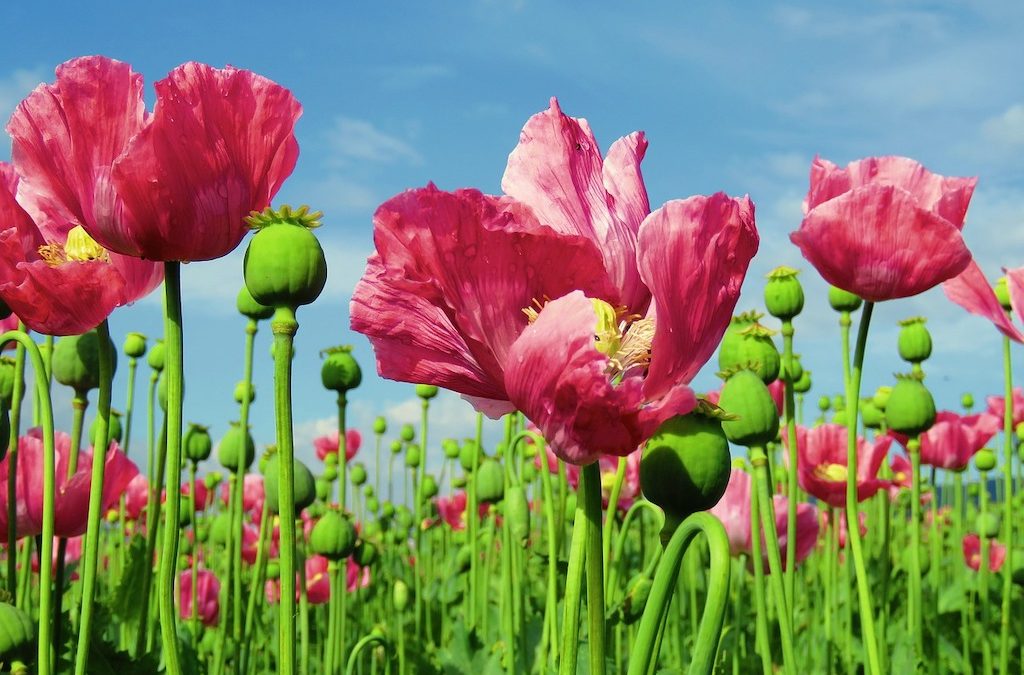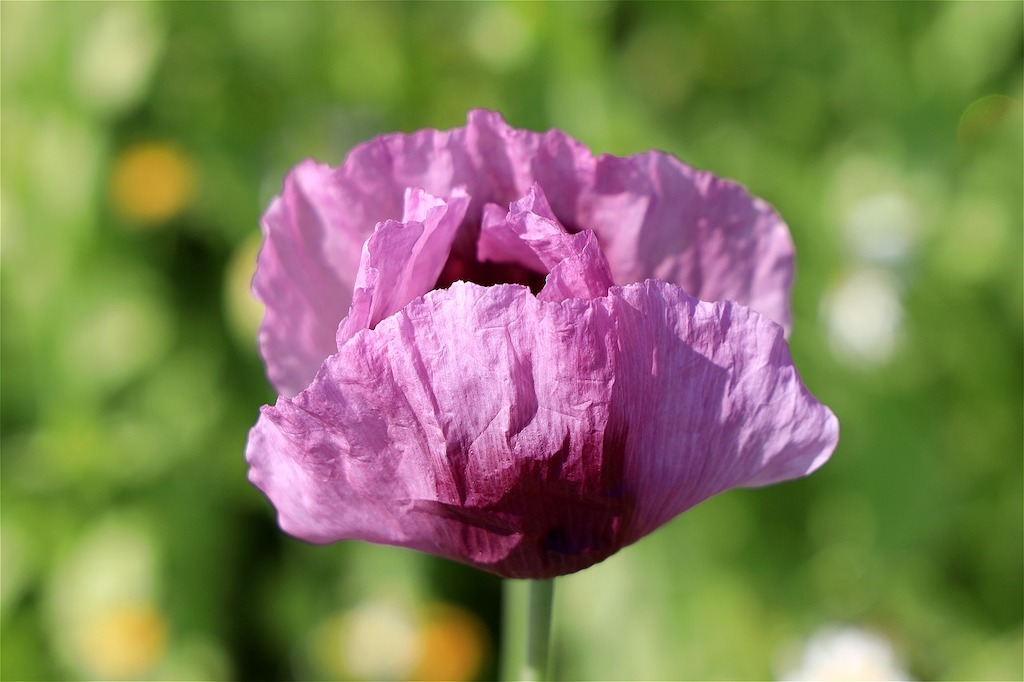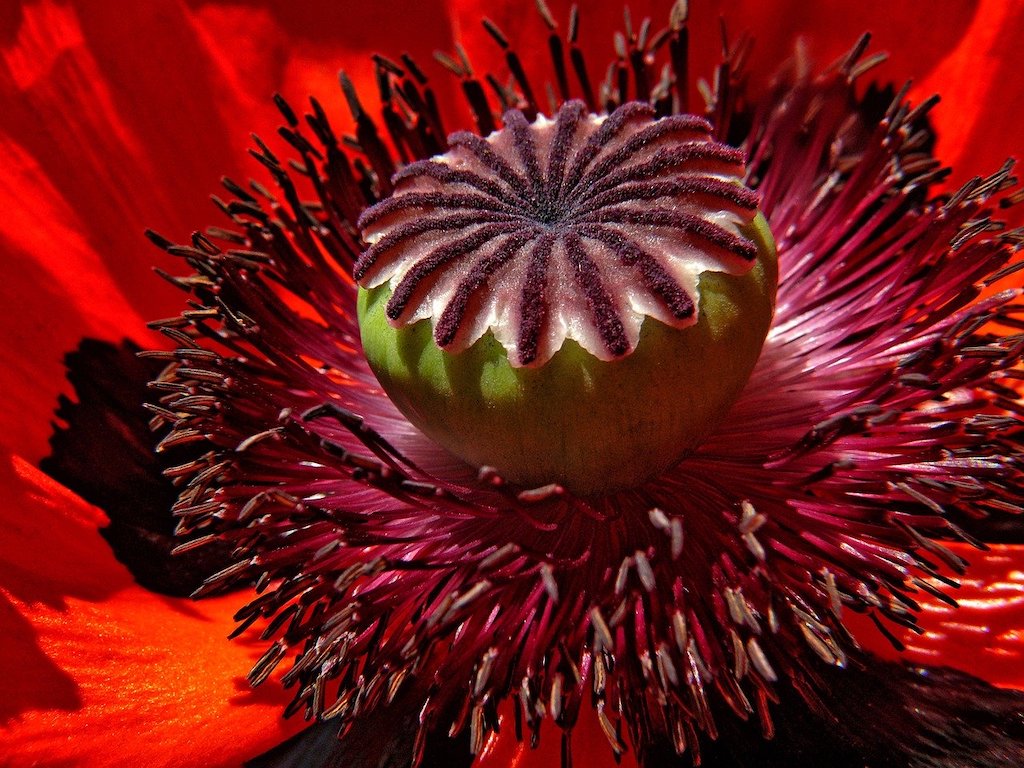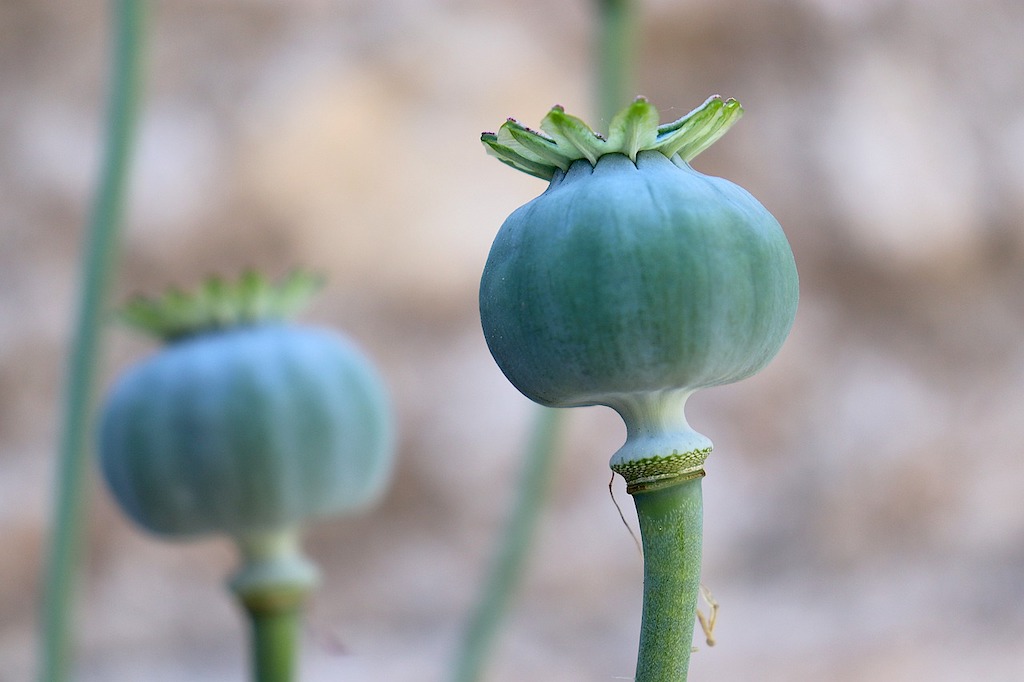
Plant Profile: Opium Poppy (Papaver somniferum)
Poppies come in almost every color. The flowers have an ephemeral, dreamy appearance, quite otherworldly and mysterious. It matches their ethnobotanical profile rather well!
Synonyms
Opium Poppy, Mawseed, Herb of Joy, Mohn, Klapper-Rosen, Mago, Magesamen, Weismagen, wilder Magen, Magensaph, Rosule
Description:
Opium Poppy is an herbaceous annual that reaches a height of between 70-130cm tall. Their showy flowers are popular with gardeners and many varieties are cultivated throughout the temperate regions. The wild variety has pale whitish-pink petals with a large dark dot at its base. Cultivated varieties are white, pink, orange, red or even dark purple. Some have a single arrangement of petals, others are double. There are even ones with frilly flower heads. The variation is truly amazing.
In the center of the flower is a prominent, many-rayed stigma surrounded by a multitude of stamens. Once the flower is fertilized the petals drop off and the seed capsule begins to swell. The size and shape vary among the different types of poppies.
The seed pod of Papaver somniferum is almost spherical with a star-shaped, flattened top, that lifts off as the capsule begins to desiccate and tiny holes begin to form underneath the rim. When the seed pod is dry and is blowing in the wind the tiny seeds are dispersed through these holes. The color of the seeds varies depending on the specific variety and can be anything from almost white to bluish-black.
The flowers are born on sturdy single stalks. The leaves are indented and clasp the stem. All green parts of the plant are glaucous and contain a milky latex which is the substance known as raw opium.

Habitat and Ecology
The genus Papaver comprises about 100 species distributed throughout the temperate regions of the world. Opium Poppies (Papaver somniferum) are often confused with their close relative, the Corn Poppy (Papaver rhoeas) a common wild species that lacks the psychoactive properties of the Opium Poppy. The two species can be distinguished by size and color:
Opium Poppies tend to be much larger. Their flowers are conspicuous, white to purple, forming large, globular seed capsules.
The Scarlet Poppy tends to be rather small, with bright scarlet-red petals and small and slender seed capsules.
In New World, Native Americans have used related species such as the Prickly Poppy (Argemone polyanthemos and A. mexicana) and the State Flower of California, the Californian Poppy (Eschscholzia californica) for medicinal purposes. Although the chemistry of these species is somewhat similar to that of Papaver somniferum, their alkaloid content is much less concentrated. Nevertheless, their ethnobotanical uses have not been entirely dissimilar: Native Poppies were used as anodynes, antispasmodics, and as sedatives. Externally, they were used to treat burns, sores, and cuts, and as a hair rinse to get rid of lice.
Opium Poppies are not native to the New World, but after they had been introduced, eastern tribes adopted them into their material medica and used them in much the same way as the settlers did who had brought them there.
The exact origin of Papaver somniferum is difficult to trace. But most researchers now agree,, that their original home is likely to have been the Mediterranean parts of Asia Minor. From here they are thought to have spread east, to Asia, south, to northern Africa, and north, into Central Europe. Today, they are even found in British gardens and some have escaped into the wild.
Poppies naturally associate with wheat, and both plants were once considered sacred to the grain-goddess Demeter. In Europe, the closely related Scarlet Poppy (Papaver rhoeas) can still be seen as colorful dots among the wheat. Scarlet Poppies have also been used medicinally, but their action is much milder than that of Papaver somniferum.
History
Beautiful to behold are the delicate Poppy flowers as they waft softly in the summer’s breeze – alas, it is a short-lived beauty. Here one day, gone the next, the fleeting splendor only lasts a few days before the falling petals expose the naked seedpod, the true keeper of the Poppy’s secret*. As the seedpod ripens, it will bulge and become filled with tiny seeds. Eventually, it begins to dry, causing the star-shaped top to lift and thereby release thousands of tiny grey-blue seeds. Every child is acquainted with them as a topping for buns or an ingredient of cakes and other baked goods. The seeds are rich in oil which Gourmet chefs value for its delicate nutty flavor. (1)
But Poppies have another property, which can bring both, great relief or misery. Within their fleshy leaves, stalks and the still green seed capsules flows a white, milky juice, which the ancients knew as ‘opion’ (2). In the ancient world, this substance was highly valued for medicinal, ritual, and recreational purposes. In fact, it has changed the course of history to no small extent. Its analgesic and sedative properties have helped many to better bear their physical or emotional pain. However, it is a highly addictive substance that traps the body and the mind into addiction, causing destruction, self-delusion, dependence, and even death to those who succumbed to its seductive powers.
But, as Paracelsus said so many centuries ago: ‘all things are poisonous; alone the dosage decides whether a substance will kill or cure’. That dictum is certainly true for Poppy. Throughout history, it has offered a great deal of relief to millions of suffering people.
Archeological evidence suggests that Poppies have been used as far back as Neolithic times. It seems that over a period of many thousands of years they have played a significant role in human culture. Remains of opium as well as poppy seeds have been found at Neolithic settlements, burial sites, and even in the frescoes on the walls inside the tombs of Egyptian Pharaohs, together with images of Mandrake and Blue Water Lily.
Poppies appear to be native to the Mediterranean. The earliest written records come from Sumeria and date to about 2000 BC. In Sumeria, it was called ‘Hul Gil’ – the Herb of Joy. It is thought that Poppy and the knowledge of its powers spread from Sumeria throughout the Middle East to Babylonia, Assyria, and Egypt, as well as to Persia and Greece. The famous Egyptian Ebers Papyrus (1500 B.C.) mentions it and recommends it as a remedy for ‘excessively crying of children’ (!). But as incredulous as that may seem, this use has remained popular in parts of Northern Africa and Europe to the beginning of this 20th century. Nevertheless, the drawbacks were also known. While it kept children quiet it was also said to ‘make them dull’. Then as now, physicians knew of the potential dangers, although addiction did not appear to have been as much of a problem in ancient times.
Opium is widely used and highly valued for its medicinal properties. It is considered the single most effective painkiller (although we now use it in a more refined and thus, more potent and more dangerous form). Furthermore, it was used as a sedative to calm hysterics and alleviate melancholy. It was thought to be one of the best remedies for treating colic, diarrhea, and persistent spasmodic coughs.
Opium has also long enjoyed a reputation as a potent aphrodisiac. Most famously, Queen Cleopatra’s reputed love-potion is said to have been a combination of opium and some type of nightshade, (probably mandrake), steeped in palm-wine.
It is mentioned in all the ancient works of medicine, from Hippocrates to Avicenna, Dioscorides, and Galen. Dioscorides described the process of obtaining this latex in detail:
“Those who wish to obtain the sap (of the Poppy) must go after the dew has dried, and draw their knife around the star in such a manner as not to penetrate the inside of the capsule, and also make straight incisions down the sides. Then with your finger wipe the extruding tear into a shell. When you return to it not long after, you will find the sap thickened and the next day you will find it much the same. Pound the sap in your mortar and roll the mass into pills.”
In ancient Greece, Poppy was sacred to Hypnos, the God of Sleep, who is often depicted with Poppy adorning his head and holding the seed capsules in his hands. Poppies guarded the threshold to his drowsy realm. Hypnos brought prophetic dreams and alleviated the pain of emotional trauma. At the temple of Asclepius, on the Greek island of Cos, Poppy was used in a kind of sleep therapy. The patients who came to the temple were given a draft of some kind of opium brew to induce visionary dreams that should reveal the method and agents, that could affect a cure.
The Romans identified Hypnos with their own God of sleep, ‘Somnus’, whose name still echoes in Poppy’s Latin name ‘Papaver somniferus’ – which comes from ‘somnus ferre’ – bringer of sleep.

But Poppy was also associated with Thanatos or Hades, the Lord of the Underworld, who rules the realm of the dead. Excessive use of its milky juice can bring eternal sleep.
Such associations reveal Poppy as a plant of the Underworld, a connection which dates to prehistoric times, as the above mentioned archeological evidence confirms. Presumably, Poppy or opium was intended to help the departed on their journey to the Underworld. (3)
Poppy was also considered sacred to Demeter, the Earth-Goddess, who taught us the art of grain cultivation, especially wheat and barley, that Poppies love to mingle with. The bulging seedpods, containing a myriad of tiny seeds serve as a perfect symbol of fertility. No doubt, the aphrodisiac qualities of opium featured prominently in the rites of this benevolent Goddess of fertility.
Some scholars believe that opium may have played a role as an important ingredient of the secret ritual drink at the Elysian Mysteries. Unfortunately, we shall never know for sure. The recipe for this potion ranks among the best-kept secrets of the ancient world.
Another myth claims that Poppy sprang from Aphrodite’s tears as she mourned the loss of her lover Adonis. In the ancient world, Cyprus, considered Aphrodite’s birthplace, was known as a major hub of Poppy cultivation. It was from here, that Poppy or Poppy products were first shipped to Egypt.
During the Middle Ages, Poppy became very popular as an aphrodisiac agent in folkloristic love magic. It was the herb of choice for love charms, philters, potions, and even some forms of divination. It was thought to reveal the identity of a future lover or foretell the outcome of a love affair. Typically, the inquirer would write a question on a piece of parchment and conceal it in a seed capsule, which he or she would then place underneath the pillow. The charm was supposed to induce a prophetic dream.
The mass of tiny seeds hidden in the round-bellied capsule symbolizes fertility and prosperity. At New Years, it was customary to make sweet-breads with Poppy seeds as a magical token of these properties and a blessing for the New Year.
Alternatively, these properties could be ‘captured’ by making a necklace with gilded Poppy heads, that served as a charm. Interestingly, it was thought that if Poppy seeds had been hidden in the bride’s shoes, it renders her infertile.
Other magical uses included a potion that was thought to infer invisibility – probably an allusion to Hades, who’s ‘cap of invisibility’, (which he had worn to conceal himself when he abducted Persephone), was thought to emulate a Poppyseed capsule.
Perhaps connected to these myths was the belief that Poppy seeds could ward off daemons and vampires – if only by distracting them. Should one of these evil creatures be on one’s heels, tossing a handful of seeds on the path behind will stop the daemons in their tracks. Forgetting their original purpose, they feel compelled to pick up and count the seeds instead.
As a medicinal agent Poppy was perhaps the most effective ingredient in the panacea known as Theriak. Emperor Nero had ordered his personal doctor, Andromachos, to produce a potion that would ease all pain and disease. Andromachos came up with ‘Theriak, a potent potion of no less than sixty different plants and substances. Galen later refined this potion and renamed it ‘Galene’. It was hailed a panacea and became popular throughout Europe, despite the fact that is was expensive and some of the ingredients were difficult to obtain.
During the Middle Ages, when ‘heroic medicine’ became the medical approach du jour, the medicinal use of opium declined. Unsympathetic doctors of the time thought of disease as a ‘divine punishment’ and saw no reason to prescribe painkilling medication. Eventually, Paracelsus created a simplified version of the original Theriak recipe. It proved extremely effective and soon surpassed even the popular appeal of the original. His concoction, known as ‘Laudanum Paracelsi’ was available in pill form. What made the pills even more effective as a painkiller was probably the addition of lemon juice, which subtly changes the chemistry of opium and enhances the anodyne action.
Laudanum was said to cure every ailment save leprosy. The glowing reports of its wondrous powers kept mounting, which meant that it was often in short supply. Scientific curiosity spurred experimentation and eventually gave rise to the groundbreaking invention of the hypodermic needle. First employed by Sir Christopher Wren in 1656 in an experiment designed to prove the theory of blood circulation, he injected the hind leg of a dog with a solution of opium. Sure enough, the drug rapidly took effect over the entire body of the dog.
In 1680, the English Doctor Thomas Sydenham revised Paracelsus’ potion once again. He intended to purify the raw drug in order to get rid it of any substances that produced ‘sickness’ if it was taken in excessive quantities. He mixed it with sherry wine, saffron, cinnamon, and cloves and named the brew ‘Sydenham’s Laudanum’.
Suddenly, opium-based products proliferated. Venice Treacle, Mithridate, London Laudanum, and Dr. Bate’s Pacific Pills became increasingly popular and opium supplies could hardly cover the demand. Nevertheless, Laudanum soon became a household name. Physicians prescribed routine dosing twice a week as a preventative remedy. Needless to say – this careless malpractice produced the first wave of mass addiction to opium. The problem was compounded by the fact that Laudanum was over-prescribed for children, which produced certain habituation and drug resistance in adulthood.
In 1700 Dr. John Jones published a book called ‘The Mysteries of Opium Revealed’, in which he extolled the marvelous properties and uses of opium as well as its pleasant side-effects in no less than 400 pages. His work was clearly biased and likely to have been strongly influenced by the author’s own intimate relationship with his subject matter. Yet, it did contain a grain of genius: Jones was the first to intuit that opium actually imitated substances already present in the body. It took another 400 years before scientists actually discovered these substances, which became known as endorphins.
Debate and experimentation continued. In 1799, Friedrich Sertürner, a young German pharmacist apprentice, observed that the effects of opium seemed to vary considerably from batch to batch. He became convinced that this must be due to the inconsistent presence of one active constituent of the raw opium. It took him only four years to isolate a substance, which he called ‘morphine’, a nod to the Greek God of sleep. Based on the fact that only a tiny amount of morphine was necessary to induce far stronger effects than the same amount of raw opium, he erroneously believed that this purified compound was safer.
Soon, several pharmaceutical companies started to produce morphine in large quantities. Wren’s hypodermic needle became the preferred method to administrate opium. The rationalization was that injecting morphine directly into the bloodstream could triple its potency.
The story of Morphine and later, heroin epitomizes the ill-conceived idea of a science-based attempt to ‘perfect nature’ and the illusion of a ‘miracle cure’, which often produces disastrous results. Nature offers many wonderful gifts, but we must use them with due respect, lest our attempts to manipulate these blessings turn them into demonic forces that are beyond our control.
(There is a dark aspect to the history of the poppy which is also very thought-provoking, especially at this point in time. It is the story of the opium wars and the colonialization of Hong Kong. It is, however, beyond the scope of this article to explore. I would strongly recommend a deep reading of this history to all who are interested in history as well as the current developments.

Medicinal Uses
Parts Used: Seeds, latex, leaves, petals
Constituents: Contains about 40 different alkaloids, most importantly, morphine, codeine, thebaine, papaverine, and narcotine
Actions: Analgesic, narcotic, sedative, antispasmodic, anti-diarrheal, antitussive, diaphoretic, aphrodisiac
Indications:
The dried latex is a well-known and highly effective painkiller and sedative. It has also been used to calm hysteric patients who are mentally or emotionally disturbed.
Its astringency makes it a powerful anti-diarrheal agent for the treatment of colic and dysentery. As an antispasmodic remedy, it can be given to calm cases of gall-bladder colic and spasms. Its anti-tussive action is highly valuable for treating persistent, spasmodic coughs (codeine is the active alkaloid here). In the past, it was much used in the treatment of tuberculosis.
As an aphrodisiac, it plays an important role in the treatment of sexual dysfunctions, such as impotency and premature ejaculation where these are due to stress and performance anxiety.
Caution:
Opium, morphine, and heroin are all highly addictive substances, besides which they are also highly illegal. Excessive use of opium leads to serious health problems and can even cause death.
This article is intended as an educational resource, not as a guide for self-medication or to encourage the use of illegal drugs.
Status: In most countries, it is illegal to cultivate Poppies without a license, although in Europe it is commonly grown as an ornamental. Harvesting opium, however, is strictly prohibited everywhere. The dried seedpods and the seeds are legal and commercially available. The dried seed pods are a popular item for crafts, dried flower arrangements, and ornaments. The seeds are used for cooking and baking. The oil, obtained by pressing the seeds, is used for cooking. In Neolithic times it was used as a lamp-oil in the lake villages of Lake Constance. The seeds are mostly used in baking.

